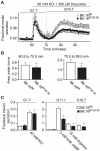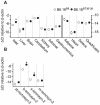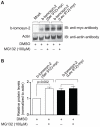Positional cloning of a type 2 diabetes quantitative trait locus; tomosyn-2, a negative regulator of insulin secretion
- PMID: 21998599
- PMCID: PMC3188574
- DOI: 10.1371/journal.pgen.1002323
Positional cloning of a type 2 diabetes quantitative trait locus; tomosyn-2, a negative regulator of insulin secretion
Abstract
We previously mapped a type 2 diabetes (T2D) locus on chromosome 16 (Chr 16) in an F2 intercross from the BTBR T (+) tf (BTBR) Lep(ob/ob) and C57BL/6 (B6) Lep(ob/ob) mouse strains. Introgression of BTBR Chr 16 into B6 mice resulted in a consomic mouse with reduced fasting plasma insulin and elevated glucose levels. We derived a panel of sub-congenic mice and narrowed the diabetes susceptibility locus to a 1.6 Mb region. Introgression of this 1.6 Mb fragment of the BTBR Chr 16 into lean B6 mice (B6.16(BT36-38)) replicated the phenotypes of the consomic mice. Pancreatic islets from the B6.16(BT36-38) mice were defective in the second phase of the insulin secretion, suggesting that the 1.6 Mb region encodes a regulator of insulin secretion. Within this region, syntaxin-binding protein 5-like (Stxbp5l) or tomosyn-2 was the only gene with an expression difference and a non-synonymous coding single nucleotide polymorphism (SNP) between the B6 and BTBR alleles. Overexpression of the b-tomosyn-2 isoform in the pancreatic β-cell line, INS1 (832/13), resulted in an inhibition of insulin secretion in response to 3 mM 8-bromo cAMP at 7 mM glucose. In vitro binding experiments showed that tomosyn-2 binds recombinant syntaxin-1A and syntaxin-4, key proteins that are involved in insulin secretion via formation of the SNARE complex. The B6 form of tomosyn-2 is more susceptible to proteasomal degradation than the BTBR form, establishing a functional role for the coding SNP in tomosyn-2. We conclude that tomosyn-2 is the major gene responsible for the T2D Chr 16 quantitative trait locus (QTL) we mapped in our mouse cross. Our findings suggest that tomosyn-2 is a key negative regulator of insulin secretion.
Conflict of interest statement
The authors have declared that no competing interests exist.
Figures









Similar articles
-
Genetic ablation of synaptotagmin-9 alters tomosyn-1 function to increase insulin secretion from pancreatic β-cells improving glucose clearance.FASEB J. 2023 Aug;37(8):e23075. doi: 10.1096/fj.202300291RR. FASEB J. 2023. PMID: 37432648 Free PMC article.
-
Phosphorylation and degradation of tomosyn-2 de-represses insulin secretion.J Biol Chem. 2014 Sep 5;289(36):25276-86. doi: 10.1074/jbc.M114.575985. Epub 2014 Jul 7. J Biol Chem. 2014. PMID: 25002582 Free PMC article.
-
Positional cloning of Sorcs1, a type 2 diabetes quantitative trait locus.Nat Genet. 2006 Jun;38(6):688-93. doi: 10.1038/ng1796. Epub 2006 May 7. Nat Genet. 2006. PMID: 16682971
-
Gene co-expression modules and type 2 diabetes.Results Probl Cell Differ. 2010;52:47-56. doi: 10.1007/978-3-642-14426-4_5. Results Probl Cell Differ. 2010. PMID: 20865371 Review.
-
The genetic basis of obesity-associated type 2 diabetes (diabesity) in polygenic mouse models.Mamm Genome. 2014 Oct;25(9-10):401-12. doi: 10.1007/s00335-014-9514-2. Epub 2014 Apr 22. Mamm Genome. 2014. PMID: 24752583 Free PMC article. Review.
Cited by
-
The N- and C-terminal domains of tomosyn play distinct roles in soluble N-ethylmaleimide-sensitive factor attachment protein receptor binding and fusion regulation.J Biol Chem. 2014 Sep 12;289(37):25571-80. doi: 10.1074/jbc.M114.591487. Epub 2014 Jul 25. J Biol Chem. 2014. PMID: 25063806 Free PMC article.
-
What the BTBR/J mouse has taught us about diabetes and diabetic complications.iScience. 2023 Jun 7;26(7):107036. doi: 10.1016/j.isci.2023.107036. eCollection 2023 Jul 21. iScience. 2023. PMID: 37360692 Free PMC article. Review.
-
Meta-Inflammation and De Novo Lipogenesis Markers Are Involved in Metabolic Associated Fatty Liver Disease Progression in BTBR ob/ob Mice.Int J Mol Sci. 2022 Apr 2;23(7):3965. doi: 10.3390/ijms23073965. Int J Mol Sci. 2022. PMID: 35409324 Free PMC article.
-
Novel regulators of islet function identified from genetic variation in mouse islet Ca2+ oscillations.Elife. 2023 Oct 3;12:RP88189. doi: 10.7554/eLife.88189. Elife. 2023. PMID: 37787501 Free PMC article.
-
Z-flipon variants reveal the many roles of Z-DNA and Z-RNA in health and disease.Life Sci Alliance. 2023 May 10;6(7):e202301962. doi: 10.26508/lsa.202301962. Print 2023 Jul. Life Sci Alliance. 2023. PMID: 37164635 Free PMC article.
References
-
- Clee SM, Yandell BS, Schueler KM, Rabaglia ME, Richards OC, et al. Positional cloning of Sorcs1, a type 2 diabetes quantitative trait locus. Nat Genet. 2006;38:688–693. - PubMed
-
- Scherneck S, Nestler M, Vogel H, Bluher M, Block MD, et al. Positional cloning of zinc finger domain transcription factor Zfp69, a candidate gene for obesity-associated diabetes contributed by mouse locus Nidd/SJL. PLoS Genet. 2009;5:e1000541. doi: 10.1371/journal.pgen.1000541. - DOI - PMC - PubMed
-
- Dokmanovic-Chouinard M, Chung WK, Chevre JC, Watson E, Yonan J, et al. Positional cloning of “Lisch-Like”, a candidate modifier of susceptibility to type 2 diabetes in mice. PLoS Genet. 2008;4:e1000137. doi: 10.1371/journal.pgen.1000137. - DOI - PMC - PubMed
-
- Zhang SH, Reddick RL, Piedrahita JA, Maeda N. Spontaneous hypercholesterolemia and arterial lesions in mice lacking apolipoprotein E. Science. 1992;258:468–471. - PubMed
Publication types
MeSH terms
Substances
Grants and funding
LinkOut - more resources
Full Text Sources
Other Literature Sources
Medical
Molecular Biology Databases
Miscellaneous

